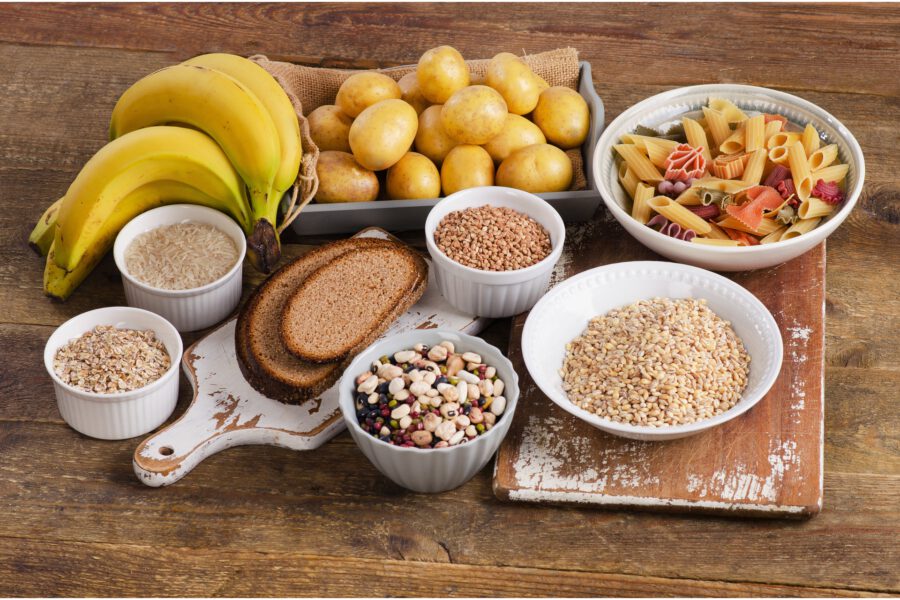Carbs Are Not Your Enemy: Why We Need Them For Fuel
Carbohydrates have gotten a bad rap in recent times. They’ve been maligned as the major culprit in the obesity epidemic and, as a result, many people avoid them completely. Others suffer from carb confusion, not really knowing whether the carbs they consume are helping or hurting them.
In this article, we’ll clarify carb confusion to provide you with the facts on this key macronutrient.
Carbohydrates are the body’s preferred form of energy. They are made up of sugars, starches, and fibers. Carbs are made up of a collection of carbon, hydrogen, and oxygen molecules. A unique characteristic of all carbohydrates is that they have a 2:1 ratio of hydrogen to oxygen.
Carbs are classified according to their chemical structure as:
- Monosaccharides
- Oligosaccharides
- Polysaccharides
Monosaccharides are the simplest form of carbs because they only contain one sugar group. As a result, they are also known as simple carbs. Oligosaccharides are short chains of monosaccharides linked together. The most common are maltose, sucrose, and lactose.
Polysaccharides are long chains of monosaccharides linked together. They include starches, glycogen, and fiber. Starches are made from plant cells through the binding of glucose monosaccharides. Glycogen is similar to starch but it is made by animal cells from glucose monosaccharides.
Dietary fiber, or cellulose, is a polysaccharide that is resistant to human enzymatic activity. As a result, it is not digested or absorbed by humans. It is, however, important for digestive health.
Unlike other types of food, as soon you put it into your mouth, carbohydrates become immediately available as energy. If we don’t require the energy straight away, it is stored for later use. The body stores carbs as glycogen in the muscles and the liver as a source of energy for movement and daily function.
However, the human body can only hold around 100 grams of glucose in the liver and around 400 grams in the muscles. When energy intake is abundant with very little energy output, the muscle and liver stores rapidly fill up and the spill-over is stored as body fat.
This process is exacerbated by the modern Western diet, which is heavily accented towards sugar-laden processed carbohydrates. These types of foods should be reduced in the diet and replaced by vegetables, moderate amounts of whole fruits, and berries.
Here’s a workout you should try:
Carbohydrates can be divided into two broad categories based on their molecular structure – simple and complex.
A simple carbohydrate is made of just one sugar molecule, which is called a monosaccharide, or two monosaccharides joined together to form a disaccharide.
Monosaccharides include fructose, glucose and galactose. Glucose occurs naturally in the foods we eat. It can also be made by the body by breaking down the complex carbohydrates that we consume. Fructose is the type of carb found in fruit.
Simple carbs are quickly absorbed into the body. They cause an immediate surge in blood glucose levels. This effect is pronounced when you eat carbs by themselves, which is one reason why you shouldn’t do so.
The surge in blood sugar causes the pancreas to increase its release of insulin in order to balance things out. However, insulin does its job too well, leading to a drop in blood sugar levels. This results in a condition known as hypoglycemia and causes a drop in energy levels, hunger and mood swings. Worse yet, it causes a craving for more sugar-based carbs, leading to a cycle that is hard to break out of.
Because they have a more intricate make-up, complex carbs take longer to break down into usable energy in the body. They should be your preferred carb source. Starchy sources such as pumpkin, sweet potato, and squash are good choices, as are beans and such grains as barely, millet, and bulgar.
Complex carbs can be further divided into starches and fibrous vegetables.
Plants store energy in the form of starch. The following are the most common starchy foods that you will encounter:
- Potatoes
- Yams
- Cereals
- Grains
- Bread
- Pasta
- Rice
- Oats
- Wheat
- Pulses
- Beans
- Corn
- Pumpkin
- Sweet Potatoes
Because the human body can digest all of the calorie energy in starchy carbs, they are said to be more calorie dense than fibrous carbs.
Vegetables contain fiber, which gives bulk to the intestinal contents, aids digestion and promotes proper elimination of waste products. That is why fiber is often referred to as ‘nature’s internal cleanser’.
Fiber is also great for promoting fat loss. Because we don’t actually digest fiber, it can help to fill us up without adding very many calories to our diet! Fiber has even been shown to slow down the release of hunger promoting hormones. In addition, fiber has been shown to reduce inflammation by changing gut permeability and pH level.
It is vital that a healthy nutrition plan includes a healthy supply of fibrous vegetables.
Here are some common types of fibrous carbs:
- Broccoli
- Asparagus
- Cauliflower
- Spinach
- Lettuce
- Brussels sprouts
- Cucumbers
- Tomatoes
- Cucumber
- Peppers
- Onions
- Bok choy
- Kale
- Mushrooms
- Courgettes
With the massive popularity of such low-carb eating protocols as the Keto Diet, it has become quite a common belief that carbohydrates are not an essential macronutrient. This is based on the fact that the body is able to use stored body fat and protein to produce the energy that it needs to function.
So, do we really need carbs?
The answer is that you do not need simple carbs, but we do need the complex variety.
Here are 5 reasons why your body needs complex carbs:
- Carbohydrates Spare Muscle Carbs prevent the breakdown of muscle tissue. They do this by promoting an anabolic environment, thanks to their ability to stimulate the release of insulin. This helps to counter the catabolic state that you get into when you train heavy with weights. By eating the right sorts of carbs at the right times, you will be able to prevent muscle tissue loss and keep your metabolism revved up for anabolism and fat loss.
- Carbs Replenish Glycogen and Reset Fat Burning Hormones When you deplete your carbs, it will take about 72 hours to drain all of the glycogen from your liver and muscle tissue. When this happens, you will be in a ketogenic state. But you will also have suppressed your fat burning hormones and severely slowed down your metabolism. However, when you regularly partake of all-natural starches and whole fruits, you will be increasing your leptin sensitivity and helping the thyroid convert T3 hormone to T4. This keeps the metabolism revved at fill capacity.
- Carbs Fuel Glycolysis High intensity activity, such as weight training, is fueled by carbs through a process called glycolysis. In fact, carbs are the body’s preferred energy source for vigorous exercise. It will help you to most efficiently generate adequate energy by promoting the production of ATP, which is the body’s primary energy system.
- Carbs Promote Post-Exercise Recovery When you work out, you quickly use up your body’s limited stores of glycogen. Taking in carbs after your workout will restore these levels, providing the energy you need to recover and rebuild your body.
- Carbs provide the Ideal Fuel Source for Your Brain and Your Body Despite what the keto diet people will tell you, fats are not a more efficient form of energy than carbs. They are simply a more concentrated form, containing 9 calories per gram, compared with 4 calories per gram for carbs. We store fat in the body as a secondary energy source. It is your reserve fuel tank. Your brain relies on glucose. If you restrict their intake you will start to get a ‘foggy’ brain. This will lead to headaches, bad moods, and feelings of nausea.
The Glycemic Index (GI) is a ranking of carbohydrates from 0 to 100 in accordance with how much they elevate blood sugar levels after food is consumed. High GI foods cause marked fluctuations in blood sugar levels.
Focusing on low-GI foods will lower insulin levels as well as insulin resistance.
Fructose has a lower GI than table sugar (sucrose), despite being a lot sweeter
Carbs such as sugar, candy, white potatoes, and breakfast cereal are high on the glycemic index. They quickly raise blood sugar levels which causes a huge spike in both sugar and insulin levels.
Low glycemic foods, such as legumes, nuts, unprocessed high-fiber grains, and vegetables don’t cause blood sugar and insulin spikes. Keeping these markers in check is important to improved health, body weight, and energy levels.
Go here to check the glycemic index of the foods in your home.
Carbs are not your enemy. But neither should they be allowed free reign in your diet. By being selective about your carbohydrate choices, quantity, and timing, you’ll be able to get a healthy balance of all three macronutrients.

